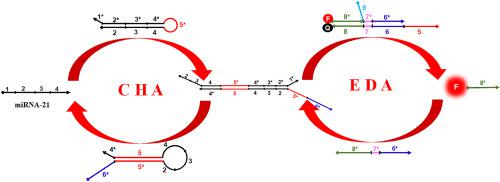Our official English website, www.x-mol.net, welcomes your feedback! (Note: you will need to create a separate account there.)
Highly sensitive miRNA-21 detection with enzyme-free cascade amplification biosensor
Talanta ( IF 6.1 ) Pub Date : 2024-03-15 , DOI: 10.1016/j.talanta.2024.125928 Qiuyan Huang , Kun Wang , Yuan Wang
Talanta ( IF 6.1 ) Pub Date : 2024-03-15 , DOI: 10.1016/j.talanta.2024.125928 Qiuyan Huang , Kun Wang , Yuan Wang

|
In this study, we present an enzyme-free fluorescence biosensor for the highly sensitive detection of miRNA-21, a crucial biomarker in clinical diagnosis. Our innovative approach combines catalytic hairpin assembly (CHA) and entropy-driven amplification into a cascade amplification strategy. MicroRNA initiates the catalytic hairpin assembly reaction, liberating the trigger region needed for the entropy-driven amplification reaction. This triggers a series of strand displacement reactions, resulting in the separation of the fluorescence resonance energy transfer pair and an amplified fluorescence signal from FAM. Our cascade amplification strategy achieves ultra-sensitive microRNA detection, with an impressive limit of detection (LOD) of 1.3 fM, approximately 100-fold lower than CHA alone. Additionally, we successfully applied this biosensor for microRNA quantification in human serum and cell lysates, demonstrating its practicality and potential for early diagnosis.
中文翻译:

使用无酶级联放大生物传感器进行高灵敏度 miRNA-21 检测
在这项研究中,我们提出了一种无酶荧光生物传感器,用于高灵敏度检测 miRNA-21(临床诊断中的关键生物标志物)。我们的创新方法将催化发夹组装 (CHA) 和熵驱动放大结合到级联放大策略中。 MicroRNA 启动催化发夹组装反应,释放熵驱动的扩增反应所需的触发区域。这会触发一系列链置换反应,导致荧光共振能量转移对分离并放大 FAM 的荧光信号。我们的级联扩增策略实现了超灵敏的 microRNA 检测,检测限 (LOD) 高达 1.3 fM,比单独使用 CHA 低约 100 倍。此外,我们成功地将这种生物传感器应用于人血清和细胞裂解物中的 microRNA 定量,证明了其实用性和早期诊断的潜力。
更新日期:2024-03-15
中文翻译:

使用无酶级联放大生物传感器进行高灵敏度 miRNA-21 检测
在这项研究中,我们提出了一种无酶荧光生物传感器,用于高灵敏度检测 miRNA-21(临床诊断中的关键生物标志物)。我们的创新方法将催化发夹组装 (CHA) 和熵驱动放大结合到级联放大策略中。 MicroRNA 启动催化发夹组装反应,释放熵驱动的扩增反应所需的触发区域。这会触发一系列链置换反应,导致荧光共振能量转移对分离并放大 FAM 的荧光信号。我们的级联扩增策略实现了超灵敏的 microRNA 检测,检测限 (LOD) 高达 1.3 fM,比单独使用 CHA 低约 100 倍。此外,我们成功地将这种生物传感器应用于人血清和细胞裂解物中的 microRNA 定量,证明了其实用性和早期诊断的潜力。



























 京公网安备 11010802027423号
京公网安备 11010802027423号